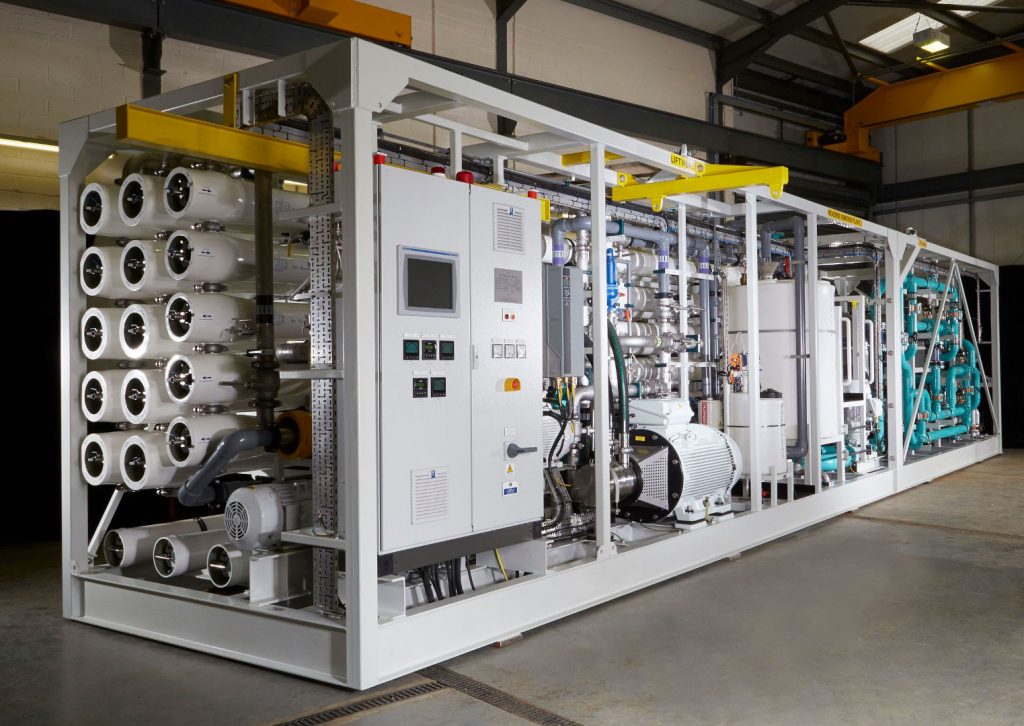Water is an essential resource on cruise ships, and ensuring a reliable supply of potable water is of great importance. Over the years, cruise ships have employed various methods to obtain freshwater from seawater. In this article, we will look at various techniques and one of the most widely used and efficient techniques – reverse osmosis (RO).
The Evolution of Seawater Desalination on Cruise Ships
In the past, cruise ships relied heavily on steam evaporation and condensing, also known as thermal water desalination. Steam ships generated copious amounts of steam – perfect as a heating medium for desalination. As ships evolved into motor ships, fuelled by hydrocarbons, either boilers to generate steam for thermal desalination or waste heat from engine cooling jackets were used. Seawater was boiled, as the water evaporated, the salt was left behind, and the freshwater vapour condensed on a cooler surface. While this method served its purpose, the evolution of ship engines with improved thermal efficiency has rendered it less effective and less viable on modern diesel, diesel-electric or LNG-fuelled ships.
Understanding Reverse Osmosis
Reverse osmosis is a water purification process that utilises a semi-permeable membrane to separate water and salts. Unlike thermal desalination, reverse osmosis offers numerous advantages, making it the preferred method for obtaining freshwater on cruise ships.
The RO Process
In reverse osmosis, seawater is subjected to pressure, forcing it to pass through the semi-permeable membrane. The pressure applied must overcome the natural osmotic pressure, where water molecules tend to move from an area of low salt concentration to an area of high salt concentration. By applying pressure, the process is reversed, allowing the less concentrated water (the permeate) to pass through the membrane while leaving the salt and impurities (the reject) behind.

Benefits of Reverse Osmosis
- Consistency of Output: RO provides a more consistent output of freshwater compared to other methods.
- Energy Efficiency: Low energy membranes are available as well as a range of energy recovery devices, making RO more energy efficient.
- Removal of Impurities: RO can effectively remove other impurities (such as bacteria and pyrogens) along with salt, resulting in superior permeate quality.
- Modular Packages: RO plants can be designed to fit into unusual spaces and/or positioned in multiple compartments.
- Retrofittable: RO plants generally have a greater degree of flexibility in how they are designed in comparison to alternative desalination technology. This flexibility makes RO plants ideal candidates for retrofitting to existing cruise ships.
Addressing RO Disadvantages
While reverse osmosis offers numerous advantages, it also comes with some drawbacks that need to be considered:
- Lower Recovery Rate: RO systems in seawater conditions may have a lower recovery rate, leading to a significant amount of rejected water. However, advanced engineering and energy recovery technologies can reduce the impact of this drawback.
- Energy Intensive: The process of reverse osmosis is energy-intensive, which can increase operational costs. There are several available energy recovery devices that can be introduced into systems to reduce the operational costs of RO plants, allied with low energy/high productivity RO membrane elements.
- Mineral Removal: RO removes some healthy minerals from the water and reduces pH levels. However, methods to rebalance the pH can be employed at the end of the process to meet drinking water standards.
- Cost and Maintenance: Implementing an RO system requires an initial investment, but considering its long-term benefits, the costs are often justified. Routine maintenance is essential to ensure the system’s efficiency and longevity, which can be managed through one of our proactive servicing plans.

Considerations for Implementing Reverse Osmosis
Before selecting a reverse osmosis system for water desalination on a cruise ship, several factors should be taken into account:
- Membrane Compatibility: RO membranes should be compatible with the water source, considering potential contact with chlorine or other disinfectants.
- Advanced Engineering: Ship designers and engineers should carefully consider the integration of RO systems and efficient servicing plans.
- Space envelope: It is important to carry out a review of the compartment/s that the RO plant is intended to be installed in, in order to maximise the space. Our flexible design service can provide a modular design to allow for this.
- Installation requirements: Consider transportation and installation, especially onto existing cruise ships, as modules need to be sized accordingly.
- Existing tie in/termination points: Explore the footprint from previous water generation equipment in order to minimise the modifications that may be required to compartments.
- Capacity: The volume of water required to be produced and if any redundancy is required. Bear in min that generally, RO plants cannot produce potable water in port/harbours. This is due to marine industry classification society guidelines and to prevent the possibility of membrane fouling as water in ports can be heavy in silt content, shallow and contaminated.
Exploring Alternative Methods
Apart from reverse osmosis, other methods such as bunkering and thermal processes have been considered for water supply on cruise ships.
- Bunkering: This method involves pumping in freshwater from port, which can be readily available in some regions. However, it limits the ship’s self-sufficiency and requires external water sources.
- Thermal Processes: While less common on modern cruise ships, most thermal processes involve using heat to evaporate seawater and then condensing the vapor back into freshwater. However, this method may not be as energy efficient as reverse osmosis. Thermal processes include multi-effect desalination/distillation (MED), multi-vapour compression (MVC) and multi-stage flash distillation (MSF)
So why use reverse osmosis on cruise ships?
Reverse osmosis has emerged as a highly efficient and environmentally friendly method for desalinating seawater on cruise ships. Despite its disadvantages, the benefits of RO, such as consistent output, energy efficiency, and effective impurity removal, make it a preferred choice for meeting the freshwater demands of modern cruise ship operations. As technology advances and engineering practices improve, reverse osmosis is likely to continue dominating the water desalination landscape on cruise ships, ensuring a safe and reliable supply of freshwater to meet passengers’ needs.